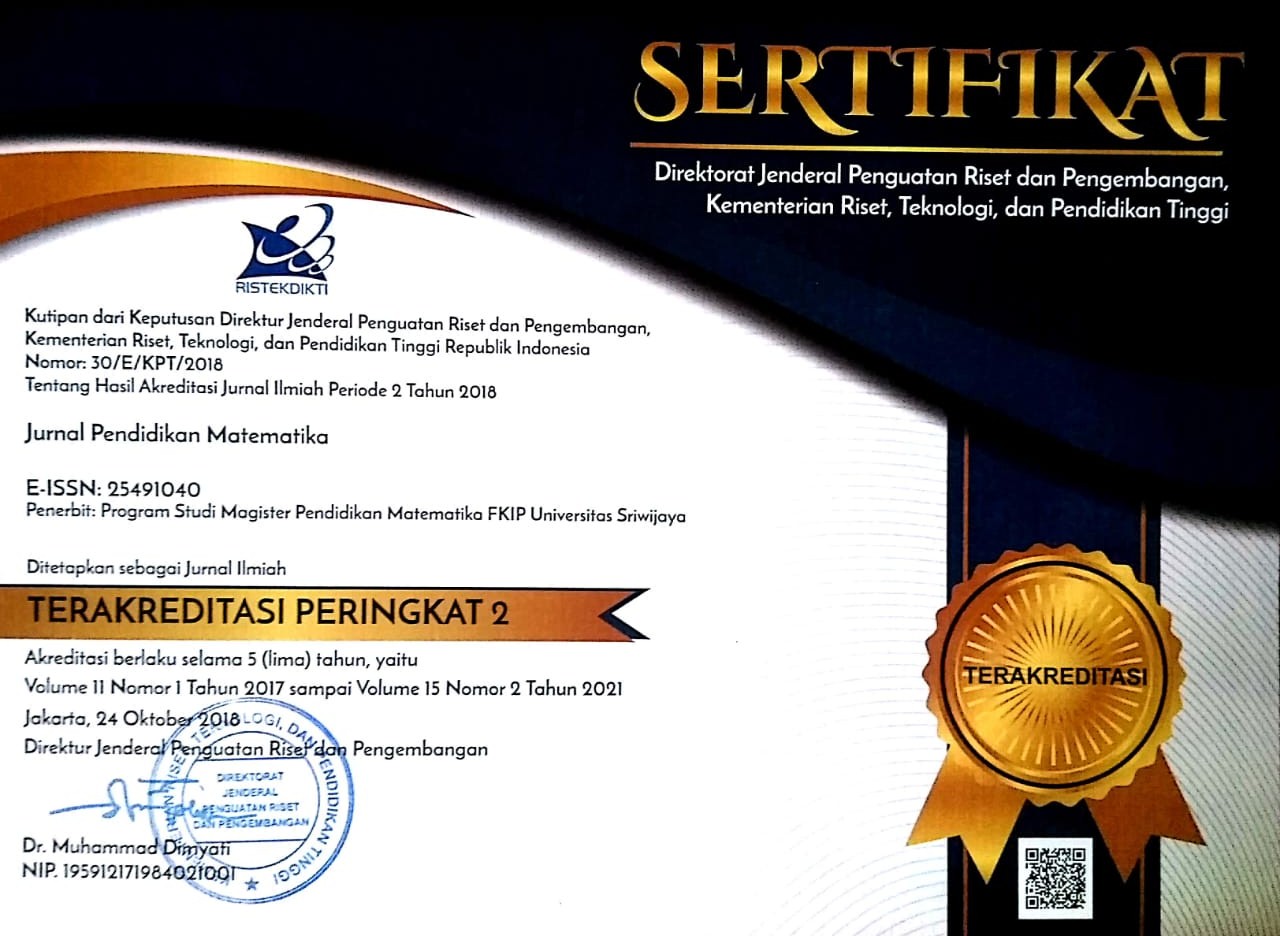Students' Numeracy Skills in Learning Cartesian Coordinate System Using PMRI in the Context of Palembang LRT
Abstract
This research aims to describe the numeracy skills of eighth grade students in learning Cartesian coordinate system using the approach of realistic mathematics education in the Indonesian context, or PMRI, by using Palembang Light Rail Transit (LRT) context. This research is a descriptive qualitative research and the research participants were students who belonged to class 8 of secondary school (SMPN) 59 Palembang. Tests and interviews with students were the data collection techniques used, and the written examination comprised two questions designed to measure the students' proficiency in mathematics. From the analysis and discussion of the students' responses, it was found that there were 11 high ability students (39.29%), eight middle ability students (52.14%), and nine low ability students (32.14%). Interviews were conducted to clarify the responses of the students. The interviews revealed that the main cause of the students' difficulties was a lack of concentration while attempting to answer the numeracy test questions. It is concluded that the students of SMPN 59 Palembang demonstrated adequate numerical skills in solving the test problems related to the Cartesian coordinate system using the PMRI approach in the context of Palembang LRT.
Keywords
Full Text:
PDFReferences
Arikunto, S. (2018). Fundamentals of Educational Evaluation [in Bahasa]. Jakarta: Bumi Aksara. Dasar-Dasar Evaluasi Pendidikan Edisi 3 - Suharsimi Arikunto - Google Buku
Ekowati, D. W., Astuti, Y. P., Utami, I. W. P., Mukhlishina, I., & Suwandayani, B. I. (2019). Numeracy literacy in muhammadiyah primary schools [in Bahasa]. ELSE (Elementary School Education Journal): Jurnal Pendidikan dan Pembelajaran Sekolah Dasar, 3(1): 93-103. https://doi.org/10.30651/else.v3i1.2541.
Fauziah, A., Putri, R. I. I., Zulkardi, & Somakim. (2020). Developing PMRI learning environment through lesson study for pre-service primary school teacher. Journal on Mathematics Education, 11(2): 193-208. https://doi.org.10.22342/jme.11.2.10914.193-208.
Fauziah, A., & Putri, R. I. I. (2022). PMRI learning design through lesson study on the material of determining the surface area of blocks [in Bahasa]. Jurnal Pendidikan Matematika: Judika Education, 5(2): 73-83. https://doi.org/10.31539/judika.v5i2.4048.
Goos, M., Geiger, V., Forgasz, H., & Bennison, A. (2020). Numeracy Across the Curriculum. London: Routledge. https://doi.org/10.4324/9781003116585.
Hardianti, S. & Zulkardi. (2018). Development of PISA type mathematics questions in the Palembang Light Rail Transit (LRT) context. Journal of Physics Conference, 1315(1), 012016. https://doi.org.10.1088/1742-6596/1315/1/012016.
Khaeroni & Nopriyani, E. (2018). The analysis of students’ learning difficulty of 5th grade primary school on topic coordinate system [in Bahasa]. AULADUNA: Jurnal Pendidikan Dasar Islam, 5(1): 76-93. https://journal.uin-alauddin.ac.id/index.php/auladuna/article/view/76-93.
Lestariningsih & Trismawati, A. (2020). Application of the PMRI approach to systems of linear equations with three variables [in Bahasa]. Jurnal Pendidikan Matematika, 11(1): 117-125. https://dx.doi.org/10.36709/jpm.v11i1.10078.
Lubur, D. N. L. (2021). Analysis of problem-solving abilities in functional material through the application of realistic mathematics education models [in Bahasa]. Jurnal Ilmiah Mandala Education, 7(1): 182-189. http://dx.doi.org/10.58258/jime.v7i1.1728.
Maulidina, A. P., & Hartatik, S. (2019). Profile of numeracy ability of primary school students with high ability in solving mathematical problems [in Bahasa]. Jurnal Bidang Pendidikan Dasar, 3(2): 61-66. https://doi.org/10.21067/jbpd.v3i2.3408.
Meitrilova, A. & Putri, R. I. I. (2020). Learning design using PMRI to teach central tendency materials. Journal of Physics: Conference Series, 1470(1), 012086. https://doi.org/10.1088/1742-6596/1470/1/012086.
MoEC. (2017). Numeracy Literacy Support Material [in Bahasa]. Jakarta: National Literacy Movement Team. https://media.neliti.com/media/publications/460683-acceleration-of-student-literature-produ-0fc9505d.pdf.
MoEC. (2021). Minimum Competency Assessment Framework (AKM) [in Bahasa]. Jakarta: Research and Development and Books Agency of the Ministry of Education and Culture. https://pusmendik.kemdikbud.go.id/an/page/download_file/613592_10.
MoECRT. (2021). Numeracy Literacy Module in Elementary Schools [in Bahasa]. Jakarta: Research and Development and Books Agency of the Ministry of Education and Culture Directorate of Primary Schools. https://ditsmp.kemdikbud.go.id/modul-literasi-numerasi/.
Nurhayati, N., & Bernard, M. (2019). Analysis of students' difficulties in solving mathematical problems for class x students of bina insan bangsa vocational school on equations and inequalities material [in Bahasa]. Journal on Education, 1(2), 497-502. https://doi.org/10.31004/joe.v1i2.103.
Nusantara, D. S. & Putri, R. I. I. (2018). The slope of a straight line in the ladder: A learning trajectory. Journal of Physics Conference Series, 1097(1), 012116. https://doi.org/10.1088/1742- 6596/1097/1/012116.
Nusantara, D. S., Zulkardi, & Putri, R. I. I. (2021). Designing PISA-like mathematics task using a covid-19 context (PISACOMAT). Journal on Mathematics Education, 12(2), 349-364. http://doi.org/10.22342/jme.12.2.13181.349-364.
OECD. (2019). PISA 2015 assessment framework key competencies in reading, mathematics, and science. Paris: OECD Publishing. https://www.oecd.org/education/pisa-2015-assessment-and-analytical-framework-9789264281820-en.htm.
Putri, R. I. I. (2011). Improving mathematics communication ability of students in grade 2 through PMRI approach. Paper presented at International Seminar and The Fourth National Conference on Mathematics Education, Yogyakarta State University, Indonesia. http://eprints.uny.ac.id/id/eprint/1371.
Putri, R. I. I., Zulkardi., & Riskanita, A. D. (2022). Students’ problem-solving ability in solving algebra tasks using the context of Palembang. Journal on Mathematics Education, 13(3): 549-564. https://doi.org/10.22342/jme.v13i3.pp549-564.
Setiyowati, N., Kurniadi, E., Suganda. V. A., & Harini, B. (2023). Problem-solving ability of class VIII students on cartesian coordinate material using mathematics modeling learning with comic learning [in Bahasa]. Teorema: Teori dan Riset, 8(1): 53-63. http://dx.doi.org/10.25157/teorema.v8i1.6801.
Van Galen, F., & Van Eerde, D. (2018). Mathematical investigations for primary school. Utrecht: Freudenthal Institute. Retrieved from http://www.fisme.science.uu.nl/en/impome/.
Van den Heuvel-Panhuizen, M., Drijvers, P. (2020). Realistic Mathematics Education. In: Lerman, S. (eds) Encyclopedia of Mathematics Education. Springer, Cham. https://doi.org/10.1007/978-3-030-15789-0_170.
Widiastuti, E. R. & Kurniasih, M. D. (2021). The influence of the problem-based learning model assisted by cabri 3d v2 software on students' numeracy literacy ability [in Bahasa]. Jurnal Cendikia: Jurnal Pendidikan Matematika, 5(2): 1687-1699. https://dx.doi.org/10.31004/cendekia.v5i2.690.
Zulkardi & Putri, R. I. I. (2019). New School Mathematics Curricula, PISA and PMRI in Indonesia. In: Vistro-Yu, C., Toh, T. (eds) School Mathematics Curricula. Mathematics Education – An Asian Perspective. Springer, Singapore. https://doi.org/10.1007/978-981-13-6312-2_3.
DOI: https://doi.org/10.22342/jpm.17.3.20239.325-342
Jl. Srijaya Negara, Bukit Besar
Palembang - 30139 Indonesia
Jurnal Pendidikan Matematika is licensed under a Creative Commons Attribution-NonCommercial-ShareAlike 4.0 International License.
Indexed in:


